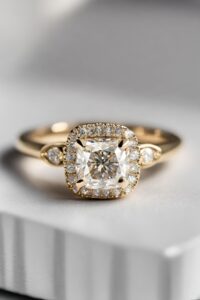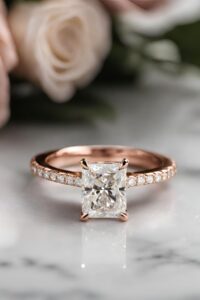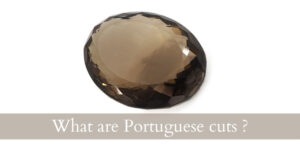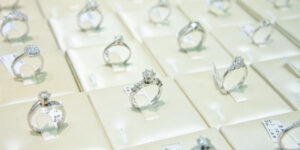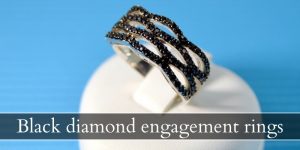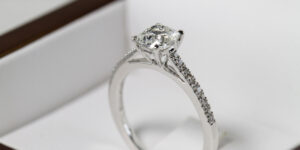When choosing your engagement ring you have a lot of options in terms of how your ring will look, but did you know some of them are considered a high profile setting, while some are a low profile setting ? Which you choose will impact how comfortable your ring will be during daily wear, and how it looks at first glance. Of course, this is not the be-all-end-all of engagement rings but definitely something you should consider when choosing your engagement ring.
Today we’re comparing low and high set rings, so you have a better idea of which would suit you and your lifestyle better. Let’s take a look.
High vs low ring setting
High ring settings allow more light into the diamond, and bring the diamond closer to your eyes. These rings can get in the way if you have a very active lifestyle, but will easily fit large carats if that is what you’re looking for. Low profile rings are better for very active lifestyles and can look very dainty and delicate when set with small diamond solitaires. Low ring settings are harder to pair with a wedding band, since you will need a curved or bespoke one, while high setting rings usually accommodate any wedding band.
What is a high ring setting ?
A high ring setting means the diamond sits high on your finger, usually with the diamond tip (culet) almost touching the ring shank. If you were to look at the ring from the profile, you’d see the diamond doesn’t go too much into the ring itself, rather it’s raised above the ring. The most common high profile settings are:
- prong/Tiffany settings, where the diamond is held in place by 4 or more prongs, usually high above the band
- cathedral settings, where the diamond’s prongs also slope gently towards the shank, forming a graceful arch
- trellis settings, where the prongs intertwine and set the diamond above the band
- basket settings, with or without hidden halos
These diamond settings are the most common diamond settings, and you will notice them on your friends’ rings, your aunts, mothers, and so on. The prong setting is the most popular, closely followed by the cathedral (for solitaires, at least).
If you’re wondering where the halo or cluster come in, those can easily be made into high or low settings and only refer to the way the accent stones are arranged. In this discussion it’s irrelevant whether your ring is a halo or not, it’s important how it’s set in a halo (prong or bezel or trellis and so on).
Read also: Solitaire VS Halo Rings
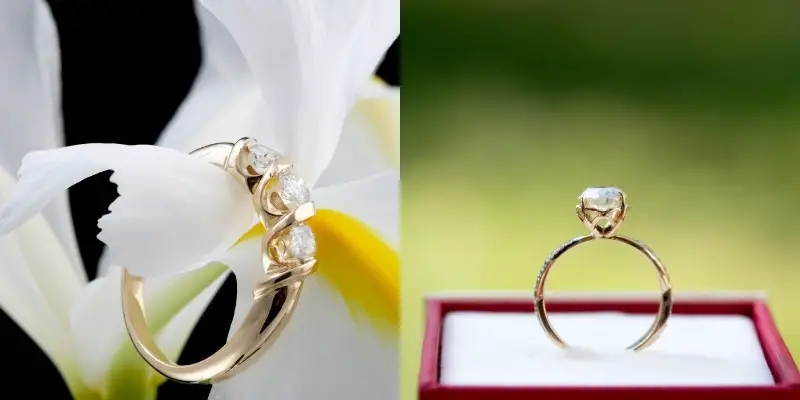
What is a low ring setting ?
A low ring setting sits very low on the finger, often flush against the skin. The culet does not touch the skin, but it intersects the ring shank, if you were to draw an imaginary line. Looking at the ring from the profile, the diamond sits lower on the ring and sometimes is completely engulfed in the ring. The most common low profile settings are:
- bezel settings (full or half), where the diamond’s girdle is surrounded by a metal band that keeps it safe
- flush settings, where the diamond is hammered into the ring itself, and is not raised above it at all
- pave settings, where the diamonds are nestled into the ring and held in place by tiny prongs
- channel settings, where the diamonds are set in a neat row with a metal band in each side covering the girdle
- bar setting, where a thin metal bar separates each gemstone and holds them in place (similar to channel)
Take a look at your e-ring inspiration photos, see what kind of setting you seem to be drawn to. The type of setting you like does not reflect quality, price tag, or prestige. There are pros and cons to low and high settings, and we’ll get into them right now.
1. High ring settings bring the diamond closer to you, allow more light
The most obvious difference is that a high profile ring will sit the diamond higher, thus closer to you, and allow more light into the diamond. When these are prong settings the result is the maximum amount of sparkle possible, since the entire diamond is exposed.
Another neat thing is that these diamond settings often look like the diamond is just floating above the ring, making it look a bit larger than it really is. And in the case of cluster and halo rings that are also high set, there is a bit of a 3D effect which makes the ring look that much more interesting.
The low profile setting rings are less in-your-face and a bit more subdued. They still sparkle, but less so because there is less light hitting the diamond, and usually just the crown and table are exposed. This can also hide the diamond in that it won’t all be visible, so it may appear a bit smaller than it really is.
2. Low ring settings are better for active lifestyles than high settings
If you’re someone who works with their hands a lot or you have a very active lifestyle (including managing very hectic toddlers) then a low setting may be a better option. These settings make sure the ring will not snag on clothes or hair, and it won’t get in the way of daily life. You should still take your jewelry off when going to the gym or the pool though.
Meanwhile a high setting can spell disaster for an engagement ring, since it will easily be hit, bumped, and scratched against many surfaces. It’s just in its nature, so you have to consider your lifestyle and whether a high profile ring will get in the way or not.
3. High ring settings allow almost any kind of wedding band
Don’t want much of a hassle when deciding on your wedding band ? A high set ring will allow any sort of wedding band you want, since the diamond will be set high and above the wedding band, so getting it flush against the ring will not be an issue. Of course there are exceptions, such as split-shank rings, or basket settings that sit flush against the skin.
In low profile rings you may have to accommodate the engagement ring shape, if you want your wedding band to sit flush. This is because some low profile rings may need a curved wedding band, or an open wedding band. Examples include:
- Princess Diana inspired rings, since those are large, are usually very low profile
- cluster rings that lay flat (such as flower, heart, or star shapes)
- odd or asymmetrical diamond and accent stone designs
So, of course, you need a wedding band that can fit that, or decide to wear your engagement ring on one hand, the wedding band on the other.
4. Low ring settings are often more secure than high settings
Since low set rings are not in harm’s way as much, they are more secure than high profile settings. This, coupled with how much stronger the holding power usually is (such as flush or bezel) you get a ring that is far less likely to lose your diamond in the long run., Of course, you can still lose a diamond in any ring, no matter the setting but you chances are much lower with a low set diamond.
And, somehow, they make for daintier looking rings, if you go for small diamonds. Which leads us to your next point.
5. High ring settings allow larger diamonds, low settings can’t easily fit them
If you’re looking for sport a big diamond than a high setting is a must, simply because there isn’t an easy way to incorporate a large gem in a low setting. So something like 4 or 5 carats could be fit into a bezel, but it will still be a higher setting than your usual 1 carat.
If you’re looking to get smaller diamonds, even in a cluster or some other arrangement, the low setting will work great. And if you want a large total carat weight (meaning all the carat weight of the diamonds in the ring combined) you will have to use several small diamonds to achieve that. Which is fine, as long as it’s the design you’re going for.
So are high set or low set rings better ?
Both high and low set rings have their good points. High set rings are the most common and popular, and this is what you will find for sale most of the time if you’re looking for ready-made rings. Of course you can always have the ring made for you and your personal style. And, if you ever change your mind, you can have your diamond re-set in a lower or higher setting down the line.

I’m the main author for jewelrymaterialguide.com. I started this site after we did tons of research before our wedding and noticed that there is information about rings, jewelry, and so on that is really hard to find on the internet.

